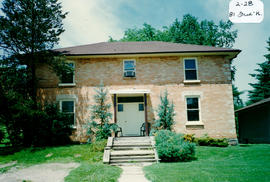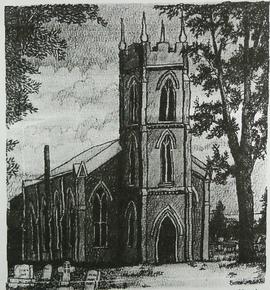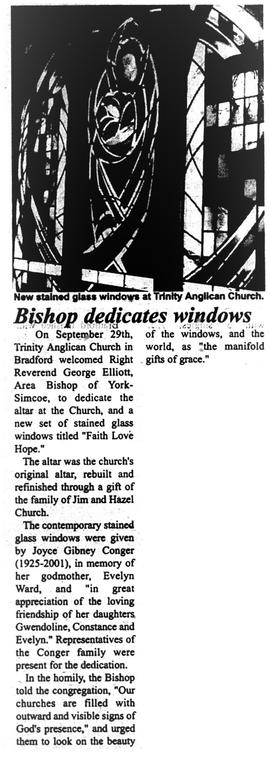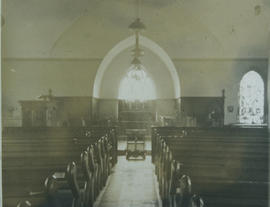The former Anglican Church Manse is located at 81 Frederick St. (on the northeast corner of Church and Frederick Streets). The structure was built around 1880 in the Eclectic Neoclassical style. The two-storey, rectangular building has a medium-pitched, hip roof. The line at the front façade suggesting that the building originally had a full-width, front porch is another Regency Revival feature. The symmetrical window openings (with high floor to ceiling heights), a centre hall plan, and a wide entrance with sidelights and a transom are neoclassical features. Dichromatic brickwork at the quoins and window labels, as well as the ‘droopy’ label stops at the windows are Gothic Revival features. The house has solid, brick construction and a stone foundation. According to the 2000 inventory, the existing porch and entrance motif are unsympathetic with the original design. It also notes that, unlike the originals, the replacement windows have no muntins. (1, 2, 3)
George JacksonAnglican
34 Archival description results for Anglican
The Bradford Presbyterian Church was once located at 81 John St. West (on the northwest corner of Church and John Streets). A Presbyterian church in Bradford dates back to 1856. The original frame building was built on this site and used until 1893. At that time it was sold to the Anglican Church and moved a short distance north to be used as the Parish Hall. The structure seen in this photo (from 1996) was designed in the Romanesque style by Siddell Baker Architects in Toronto. It was constructed in 1893 for $5,000 by local builder Dougald (George) MacDonald. George was able to do short-hand blueprints and he was also the Sunday school teacher. The church pipe organ was installed in 1915 (with a portion of it funded by the Carnegie Foundation). A seven-foot section of interior, cornice molding fell off and crashed through some front seating and the floor and landed in the basement in 1937. It was rediscovered years later in George MacDonald’s barn.
The 1½-storey building had a modified, cruciform plan with an apse, narthex, and square and polygonal entrance towers. There was a steeply-pitched, gable roof with pyramidal and polygonal roofs on the towers. This structure was a complex massing of heavy, simple forms, each of which had a clear function. The main entrance was through a large, round-arched doorway with a crescent-shaped transom light and a heavy, panelled, wood door. It was set into a high, square tower at the southeast corner of the church and it marked the site as a landmark within the town. Tall, narrow, window openings had thin windows with a vertical emphasis. Some secondary windows were set in rectangular openings (but with the same narrow proportions). Windows having round-arched openings of various sizes in groups, and as singles, lit the nave. The simplicity of this church and the lack of typical Romanesque Revival details such as heavy, stone stringcourses and lintels gave the church a Norman feel with its squared tower and massive walls. Square pinnacles topped the four corners of the entrance tower. The building had masonry construction with brick cladding and a cut-stone foundation. Len Saint, a local stone mason and brick layer, did the plastering for the church. There were metal panels on the steeple and tower roofs. According to the 2000 inventory, the church was in excellent condition with many original features.
The congregation moved to St. John’s Presbyterian Church which was located on the Middleton Sideroad (circa 2004). Trinity Anglican Church purchased the old Presbyterian Church building and land in 2004 and the building was demolished in 2005 to provide additional parking for the congregation of Trinity Anglican Church. (1, 3, 4, Trinity Anglican Church Bradford website)
Description : On the north side of the 7th Line, about 1 km. west of Bond Head, there is a metre-high cairn in the fence line, that marks the location of the home and church built by the Rev. Featherstone Osler in the late 1830s. The frame church, that would become Trinity Anglican Church in Bond Head, was initially planned a lecture base for divinity students, church school, and centre for baptisms and marriages. It was during this time, that four sons were born to the Oslers - Feathersone, Britton, Edmund and William. The two elder sons became lawyers of note, Edmund a banker, and William, a doctor who was knighted for his service to his fellow man, and whose work changed the nature of medical practice and diagnosis. A number of medical facilities in Ontario have been named in honour of Sir William Osler, and at Trinity Anglican Church today, a memorial window and brass plaque are of great interest to the members of the medical profession who come from all over the world to visit the birthplace of this leader of their chosen profession. The Osler timber-frame country church, with its stucco coating, was moved in September of 1885 from the 7th Line to the top of the hill, at the northwest corner of Bond Head. It was rollered down the rural road in sections, reassembled, then given a veneer of brick and a new steeple. New oak pews were installed, and the interior was trimmed in oak. Much of the original interior and exterior still survive, including items used by Rev. Osler himself. On December 20th, 1885, Rev. Osler travelled from his Dundas charge to officially open the renovated church in its new location. Recently, Dr. Watters, a local resident and retired surgeon, speaking to the Bradford West Gwillimbury Local History Association, stated, "The old Osler church built and preached in by the Reverend Featherstone Osler, home to his astonishing family, is a piece of Canadian history of interest around the world. We must find some way to preserve the Osler church as part of that character, and as a reminder of the kind of people who began it."
Bradford West Gwillimbury TimesA sketch of the Holland Landing Anglican Church as it appeared in the Holland Landing Scope. The caption read: "The Holland Landing Anglican Church is a landmark in that community, as represented here in a sketch by Simon Limbert. The community was officially named in 1821 when the first post office was established. The church was constructed in 1850 from materials taken from an older building.
The barn located on the east side of Essa St. (south of Frederick St.) belonged to the former Anglican Manse. The Manse was located at 81 Frederick St. (1, 2)
George JacksonEvent Date : Thursday, September 09, 1971
Event Type : Death
Municipality : Brampton, Ont.
Description : After a lengthy illness, Hazel Atkinson of R.R. 3, Schomberg, and a well-known resident of this area, passed away Thursday, Sept. 9 at Peel Memorial Hospital in Brampton. She was born Hazel Jane Lucille Armstrong on Sept. 23, 1895 on the 7th Line of Mono Township, Lot 30, near Rosemont. Her parents were John William Armstrong and his wife, Elizabeth Murphy. Her grandparents were Andrew Murphy and his wife, Frances Little and Robert Armstrong, and his wife, Jane McElroy - all natives of Ireland. Mrs. Atkinson was quite proud of her Irish ancestry. As a girl, Mrs. Atkinson attended School No. 17, Mono Township and later Alliston High School. In religion, she was an Anglican and attended St. Luke's Church, Mulmur Township. After her marriage in 1922 to Leonard Atkinson, they moved to Lot 15, 2nd Concession of Tecumseth Township and three years later to Lot 17, 11th Concession, King Township and in 1945 to Lot 17, 10th Concession, King Township. In later years, she remained in the same area. Her only brother, Oswald, predeceased her in 1953. A son, Wesley, passed away Jan. 29, 1948 and her husband, Leonard passed away March 30, 1956. She leaves the following family: Phyllis (Mrs. Joseph Kerr), R.R. 1, Bolton; Evelyn (Mrs. Hiram Littleton), Bradenton, Florida; Harvey, Bolton; Violet (Mrs. Gordon Troyer), R.R. 1, Woodbridge; Risdon and Roy of R.R. 3, Schomberg. Also there are 16 grandchildren and 2 great-grandchildren. She rested at Egan's Funeral Home, Bolton until Sunday at 2:30. Funeral service was conducted by Rev. Bob Leckey, Anglican minister, Bolton. Burial took place at Laurel Hill Cemetery, Bolton. Pallbearers were her nephews: Lloyd Armstrong, Joe Maw, Ben Parr, Ross Atkinson, Ed Hebor, and Bill Clark. Flower bearers were Harold Fuller, Stan McGill, Jim Connell and Art Richards. It was a largely-attended funeral with friends and relatives coming from as far away as Windsor and North Bay to pay their respects.
Bradford WitnessAudrey Evans Dies After Brief Illness
Bradford lost a special lady last week. Audrey Evans, wife of former Bradford Mayor and Simcoe Centre MPP, D. Arthur Evans died early Wednesday morning, April 29, at York County Hospital in Newmarket after a sudden illness.
Mrs. Evans, 63, was taken ill while she and her husband vacationed with friends in Pheonix, Arizona on April 14.
Mr. Evans said she "miraculously" regained consciousness while in hospital in Pheonix to greet her children who had rushed to her bedside, then lapsed into a coma shortly afterward.
She was flown back to Canada the day prior to her death. He family was with her when she died.
NEAR ALLISTON
Born Audrey Myrtle Kerr, Mrs. Evans was the daughter of Selby Britton and Myrtle Kerr who owned a farm near Alliston.
Mr. Evans recalled meeting his wife at a dance while they were both teenagers. "We went together for five years and were married in 1939 in the Anglican Church in Rosemount," he said.
The couple celebrated their 42nd wedding anniversary while they were in Pheonix.
After their marriage they settled in Bradford where Mr. Evans operated a business and was ready to embark on his long political career, culminating in his election as Bradford's first mayor and MPP in 1960.
POLITICAL LIFE
"There is absolutely no way I could have done it without her," he commented. "I couldn't have had a better wife for a political life."
A charming, friendly lady, Mrs. Evans proved as staunch a campaigner as her husband. "She really enjoyed it," he recalled.
As well as helping her husband through successive political campaigns, Mrs. Evans was also an active members of the IODE and Anglican Church Women, and taught Sunday school as Trinity Anglican in Bradford.
Before a serious operation about four years ago, Mr. Evans said, she also enjoyed curling and playing golf.
"She was very active with young people. Our children's friends were always made welcome in our home. She just loved young people." Mr. Evans said.
Mourners Friday overflowed the chapel of the Lathangue-Skwarchuk Funeral Home where a funeral service for Mrs. Evans was conducted by Rev. Garnett Whitfield of Trinity Anglican Church.
Rev. Whitfield himself recalled first meeting Mrs. Evans as she typically offered assistance while he and Mrs. Whitfield were moving into their home last year.
FAMILY
Audrey Evans leaves her husband Art, children John, Don, Robin, Cathy (Mrs. Luis Arruda), and grandchildren Martina, David, Tara, Reagan, Becky, Justin, and Tiffany. She also leaves a brother, Borden.
Interment took place at Coulson's Hill cemetery.
Pallbearers were Keith Noble, Jack Constable, Ron Whiteside, Tim Fuller, Art Turner, and Doug Stewart.
Flower bearers were Ken Tupling, Walt Edney, Lloyd Kneeshaw, Bus Culbert, Keith Stevens, Jim McClocklin, Charlie Evans, and Ross Hughes.
Bradford Witness"On September 29th, Trinity Anglican Church in Bradford welcomed Right Reverend George Elliott, Area Bishop of York-Simcoe, to dedicate the altar at the church, and a new set of stain glass windows titled Faith Love Hope"
Bradford West Gwillimbury TimesIf you have any additional information about this photo please contact the library at 905-775-3328.
Interior of the Bond Head Anglican Church.
Bradford West Gwillimbury Public Library






